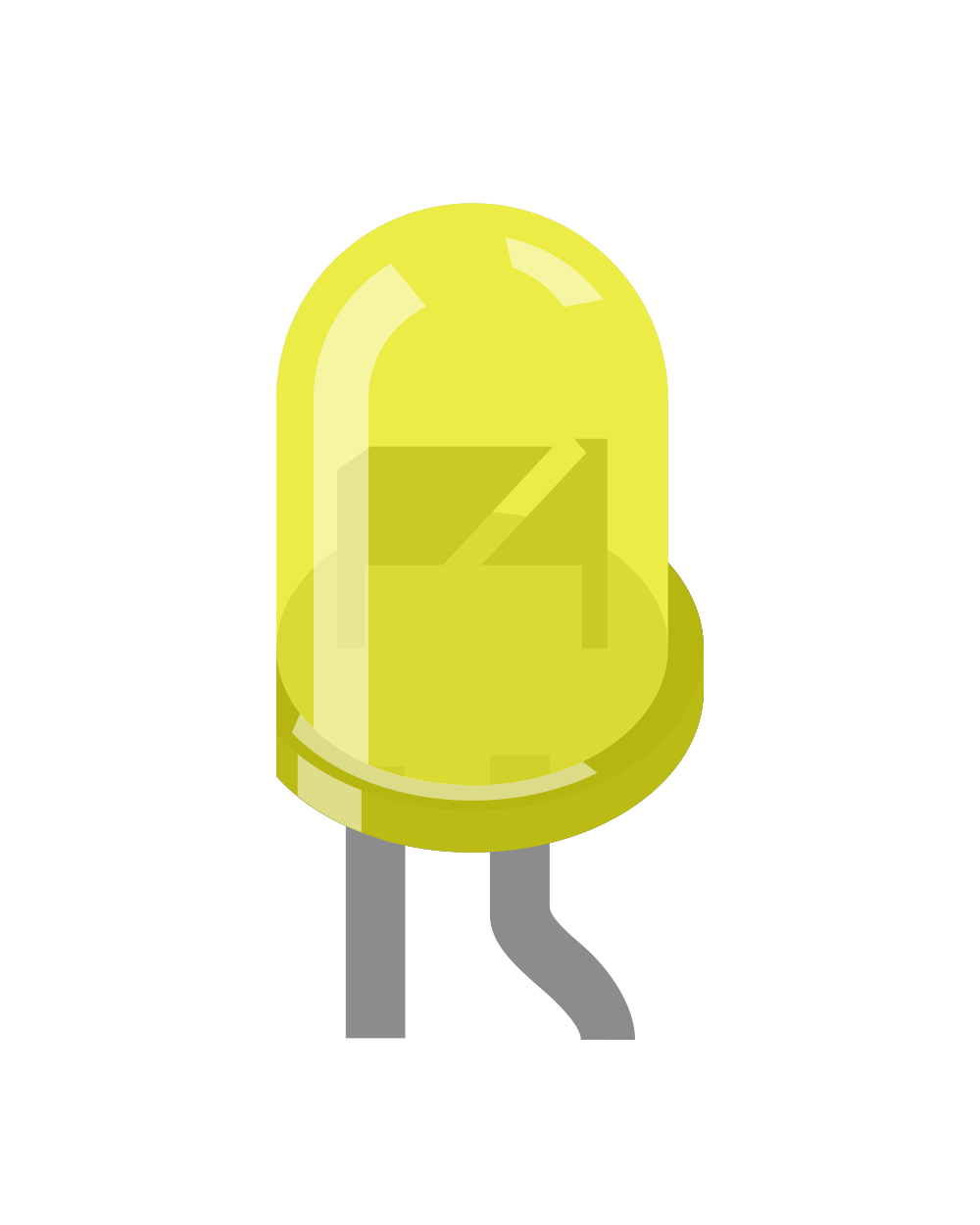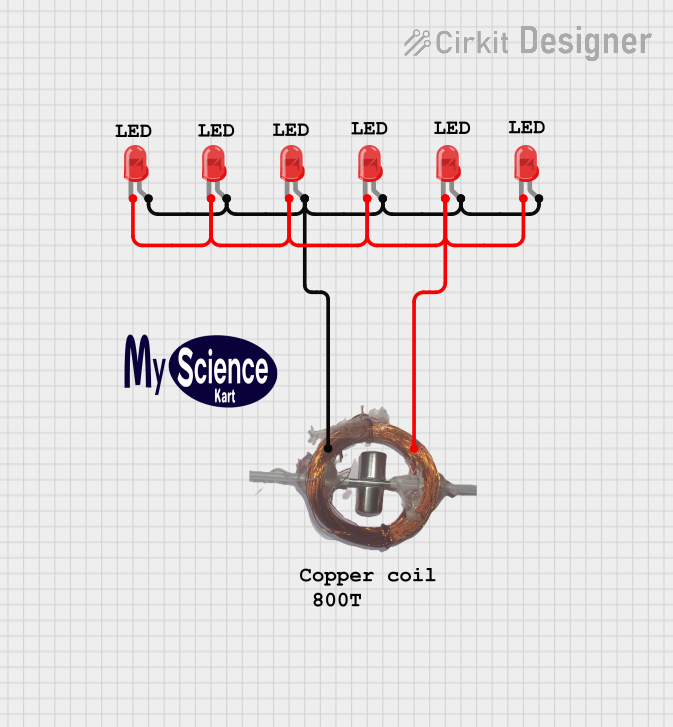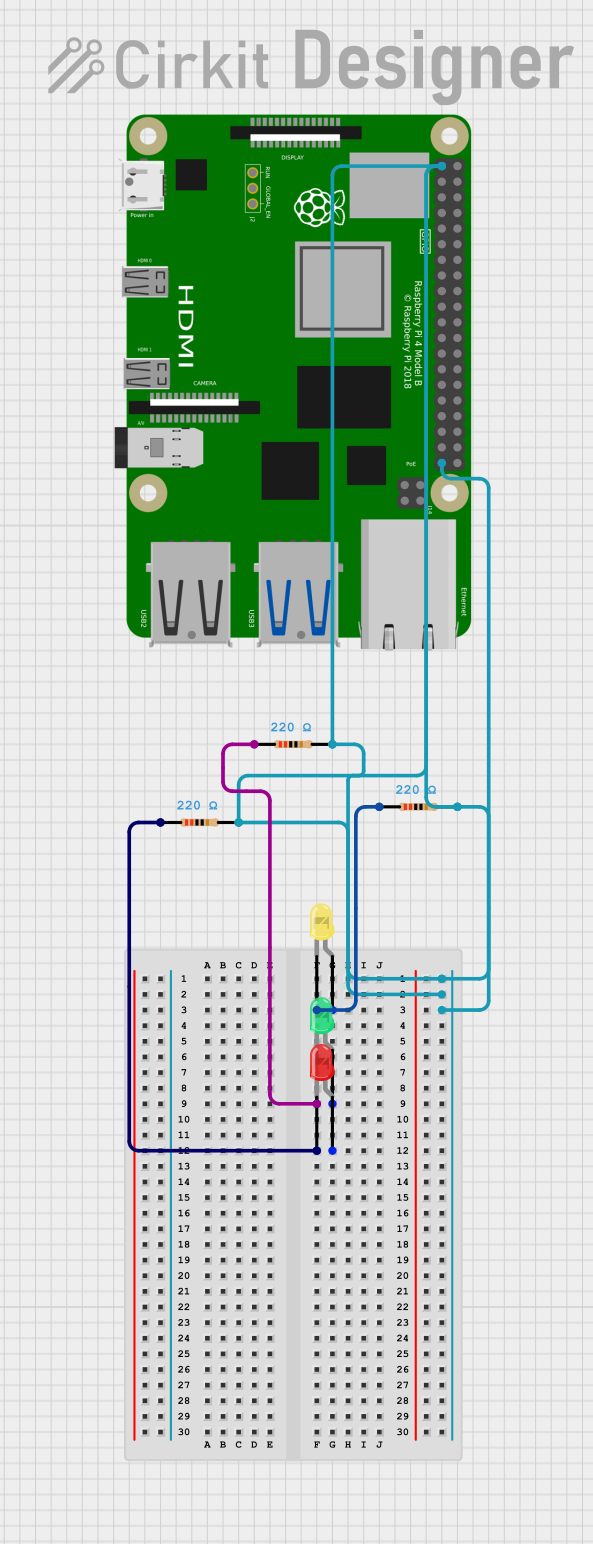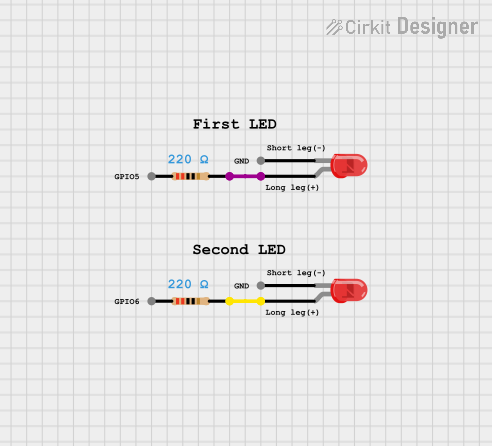
How to Use LED Two Pin (Yellow) : Examples, Pinouts, and Specs

 Design with LED Two Pin (Yellow) in Cirkit Designer
Design with LED Two Pin (Yellow) in Cirkit DesignerIntroduction
The LED Two Pin (Yellow) is a light-emitting diode that emits yellow light when an electric current flows through it. This component is widely used in electronic circuits for visual indicators, status displays, and decorative lighting. Its compact size, low power consumption, and long lifespan make it an essential component in various applications.
Explore Projects Built with LED Two Pin (Yellow)

 Open Project in Cirkit Designer
Open Project in Cirkit Designer
 Open Project in Cirkit Designer
Open Project in Cirkit Designer
 Open Project in Cirkit Designer
Open Project in Cirkit Designer
 Open Project in Cirkit Designer
Open Project in Cirkit DesignerExplore Projects Built with LED Two Pin (Yellow)

 Open Project in Cirkit Designer
Open Project in Cirkit Designer
 Open Project in Cirkit Designer
Open Project in Cirkit Designer
 Open Project in Cirkit Designer
Open Project in Cirkit Designer
 Open Project in Cirkit Designer
Open Project in Cirkit DesignerCommon Applications
- Power and status indicators in electronic devices
- Signal and warning lights
- Decorative lighting in DIY projects
- Educational and prototyping purposes
- Displays in control panels and dashboards
Technical Specifications
Below are the key technical details for the LED Two Pin (Yellow):
| Parameter | Value |
|---|---|
| Forward Voltage (Vf) | 2.0V to 2.2V |
| Forward Current (If) | 20mA (typical) |
| Maximum Current (Imax) | 30mA |
| Wavelength | 590nm (yellow light) |
| Viewing Angle | 20° to 30° |
| Power Dissipation | 60mW |
| Reverse Voltage (Vr) | 5V (maximum) |
| Operating Temperature | -40°C to +85°C |
| Package Type | 5mm or 3mm (commonly used) |
Pin Configuration
The LED Two Pin (Yellow) has two terminals: the anode and the cathode. The table below describes the pin configuration:
| Pin Name | Description |
|---|---|
| Anode | Positive terminal; connect to the positive side of the circuit. |
| Cathode | Negative terminal; connect to the ground or negative side of the circuit. |
Note: The cathode is typically identified by a shorter lead or a flat edge on the LED casing.
Usage Instructions
How to Use the LED in a Circuit
Determine the Resistor Value: To prevent damage to the LED, always use a current-limiting resistor in series with the LED. The resistor value can be calculated using Ohm's Law: [ R = \frac{V_{supply} - V_f}{I_f} ]
- (V_{supply}): Supply voltage
- (V_f): Forward voltage of the LED (2.0V to 2.2V)
- (I_f): Desired forward current (typically 20mA)
For example, if (V_{supply} = 5V), (V_f = 2.1V), and (I_f = 20mA): [ R = \frac{5V - 2.1V}{0.02A} = 145\Omega ] Use the nearest standard resistor value (e.g., 150Ω).
Connect the LED:
- Connect the anode (longer lead) to the positive side of the circuit.
- Connect the cathode (shorter lead) to the negative side or ground.
Power the Circuit: Apply the appropriate voltage to the circuit. The LED will emit yellow light when powered correctly.
Important Considerations
- Polarity: LEDs are polarized components. Reversing the polarity may prevent the LED from lighting up or cause damage.
- Current Limiting: Always use a resistor to limit the current through the LED. Exceeding the maximum current rating can permanently damage the LED.
- Heat Dissipation: While LEDs generate minimal heat, ensure proper ventilation in high-power applications.
Example: Connecting to an Arduino UNO
Below is an example of how to connect and control a yellow LED using an Arduino UNO:
Circuit Setup
- Connect the anode of the LED to digital pin 9 on the Arduino through a 150Ω resistor.
- Connect the cathode of the LED to the GND pin on the Arduino.
Arduino Code
// This code blinks a yellow LED connected to pin 9 of the Arduino UNO.
// Ensure a 150Ω resistor is used in series with the LED to limit current.
const int ledPin = 9; // Define the pin connected to the LED
void setup() {
pinMode(ledPin, OUTPUT); // Set the LED pin as an output
}
void loop() {
digitalWrite(ledPin, HIGH); // Turn the LED on
delay(1000); // Wait for 1 second
digitalWrite(ledPin, LOW); // Turn the LED off
delay(1000); // Wait for 1 second
}
Troubleshooting and FAQs
Common Issues
LED Does Not Light Up:
Cause: Incorrect polarity.
Solution: Ensure the anode is connected to the positive side and the cathode to the negative side.
Cause: No current-limiting resistor or incorrect resistor value.
Solution: Verify the resistor value and ensure it is connected in series with the LED.
LED Flickers or is Dim:
- Cause: Insufficient current or unstable power supply.
- Solution: Check the power supply voltage and ensure the resistor value is appropriate.
LED Burns Out Quickly:
- Cause: Excessive current through the LED.
- Solution: Use a resistor with the correct value to limit the current.
FAQs
Q: Can I connect the LED directly to a 5V power supply without a resistor?
A: No, doing so will likely damage the LED due to excessive current. Always use a current-limiting resistor.
Q: How do I identify the anode and cathode of the LED?
A: The anode is the longer lead, while the cathode is the shorter lead or the side with a flat edge on the casing.
Q: Can I use the LED with a 3.3V power supply?
A: Yes, but you still need a current-limiting resistor. Calculate the resistor value based on the supply voltage and forward voltage of the LED.
Q: What happens if I exceed the maximum current rating?
A: Exceeding the maximum current rating can cause the LED to overheat and fail permanently.
By following these guidelines, you can effectively use the LED Two Pin (Yellow) in your electronic projects.